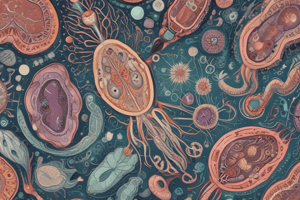Podcast
Questions and Answers
What is a common consequence of hookworm infections?
What is a common consequence of hookworm infections?
- Cardiac failure
- Severe diarrhea
- Iron-deficiency anemia and protein deficiency states (correct)
- Blindness
What is the primary route of hookworm larvae invasion?
What is the primary route of hookworm larvae invasion?
- Through the eyes
- Through the respiratory system
- Through contaminated food and water
- Through skin invasion, particularly the lower extremities and feet (correct)
What is the term used to describe the intense itching caused by hookworm larvae?
What is the term used to describe the intense itching caused by hookworm larvae?
- Ground itch
- Toe itch
- Pruritis
- All of the above (correct)
What is a potential consequence of untreated hookworm infections?
What is a potential consequence of untreated hookworm infections?
What is a characteristic of chronic hookworm disease?
What is a characteristic of chronic hookworm disease?
What is the name of the lesions that form as a result of hookworm larvae migration through the skin?
What is the name of the lesions that form as a result of hookworm larvae migration through the skin?
Where do adult Ancylostoma duodenale worms typically inhabit?
Where do adult Ancylostoma duodenale worms typically inhabit?
What is a symptom of hookworm infection in children?
What is a symptom of hookworm infection in children?
What is a complication of hookworm infection?
What is a complication of hookworm infection?
What is the infective stage of Ancylostoma duodenale?
What is the infective stage of Ancylostoma duodenale?
How do Ancylostoma duodenale worms attach themselves to the small intestine?
How do Ancylostoma duodenale worms attach themselves to the small intestine?
What happens to the eggs of Ancylostoma duodenale after they are passed out in the feces?
What happens to the eggs of Ancylostoma duodenale after they are passed out in the feces?
How do people usually get infected with Ancylostoma duodenale?
How do people usually get infected with Ancylostoma duodenale?
What is a rare mode of infection for Ancylostoma duodenale?
What is a rare mode of infection for Ancylostoma duodenale?
What happens to the larvae of Ancylostoma duodenale after they penetrate the skin?
What happens to the larvae of Ancylostoma duodenale after they penetrate the skin?
What is a difference between Ancylostoma duodenale and Necator americanus?
What is a difference between Ancylostoma duodenale and Necator americanus?
Flashcards
Where do adult hookworms live?
Where do adult hookworms live?
Adult hookworms live in the small intestine, attaching to the mucous membrane with their mouthparts. They are typically found in the jejunum, and less commonly in the duodenum or ileum.
What is the infective stage of a hookworm?
What is the infective stage of a hookworm?
The infective stage of a hookworm is the third-stage filariform larva (L3). This larva is capable of penetrating human skin.
How do hookworms reproduce?
How do hookworms reproduce?
Hookworms reproduce by laying eggs, which are released in the feces of infected individuals.
How many adult worms develop from one infective larva?
How many adult worms develop from one infective larva?
Signup and view all the flashcards
How do people get infected with hookworms?
How do people get infected with hookworms?
Signup and view all the flashcards
What is the path of the larvae after entering the body?
What is the path of the larvae after entering the body?
Signup and view all the flashcards
Where do larvae finally develop into adult worms?
Where do larvae finally develop into adult worms?
Signup and view all the flashcards
Compare the size of Necator americanus to Ancylostoma duodenale.
Compare the size of Necator americanus to Ancylostoma duodenale.
Signup and view all the flashcards
How do the eggs of Necator americanus and Ancylostoma duodenale compare?
How do the eggs of Necator americanus and Ancylostoma duodenale compare?
Signup and view all the flashcards
What is the general difference in the life cycle of Necator americanus and Ancylostoma duodenale?
What is the general difference in the life cycle of Necator americanus and Ancylostoma duodenale?
Signup and view all the flashcards
What are some initial symptoms of hookworm infection?
What are some initial symptoms of hookworm infection?
Signup and view all the flashcards
What is a common complication of long-term hookworm infection?
What is a common complication of long-term hookworm infection?
Signup and view all the flashcards
What are the characteristic skin lesions caused by hookworm larvae?
What are the characteristic skin lesions caused by hookworm larvae?
Signup and view all the flashcards
What symptoms can occur when hookworm larvae migrate through the lungs?
What symptoms can occur when hookworm larvae migrate through the lungs?
Signup and view all the flashcards
Study Notes
Ancylostoma duodenale (Hookworm)
- Adult worms live in the small intestine of infected persons, mainly in the jejunum, occasionally in the duodenum, and rarely in the ileum.
- They are relatively stout, cylindrical, pale pink or greyish white, and may appear reddish brown due to ingested blood.
Life Cycle
- Involves only one host (human).
- Infective stage is the third-stage filariform (L3) larva.
- Adult worms attach themselves to the mucous membrane by means of their mouth parts.
- Female worms lay eggs, which are passed out in the feces of infected persons.
- Eggs develop in the soil, and a rhabditiform larva hatches out, molts twice, and becomes the third-stage infective filariform larva.
- A single infective larva develops into a single adult, male or female.
Mode of Infection
- Infection occurs when a person walks barefooted on soil containing the filariform larva, which penetrate the skin and enter the subcutaneous tissue.
- Rarely, infection may take place by the oral route.
- Transmammary and transplacental transmission has been reported for Ancylostoma.
Life Cycle (continued)
- Inside the human body, the larvae are carried through the venous circulation to the right side of the heart and lungs.
- They escape from the pulmonary capillaries into the alveoli, migrate up the respiratory tract to the pharynx, and are swallowed, reaching the small intestine.
- During migration, they undergo a third moult and develop a buccal capsule, which they use to attach themselves to the small intestine and grow into adults.
Necator Americanus
- Adult worms are slightly smaller than A. duodenale.
- Eggs of N. americanus are identical with those of A. duodenale.
- Life cycle is similar to that of A. duodenale.
Pathogenicity and Clinical Features of Hookworm Infection
- Symptoms can be linked to inflammation of the gastrointestinal system stimulated by feeding hookworms.
- Inflammation is accompanied by nausea, abdominal pain, and intermittent diarrhea.
- Progressive anemia (iron-deficiency anemia) and protein deficiency states often occur in prolonged infections.
- Patients with more severe infections may experience vomiting, general fatigue, and dysentery.
- Untreated infections may lead to hemorrhage, edema, and fatal consequences.
- Characteristics of chronic hookworm disease include emaciation, wasting, cardiac failure, abdominal distension, and delayed mental and physical development in children.
Larval Stage
- Hookworm infections begin with larval invasion of the skin, particularly the lower extremities and feet.
- Lesions resemble spider bites and insects, causing intense itching (pruritis) and blistering, known as "ground itch" or "toe itch".
- Migration of larvae through the skin causes lesions called vesicles containing serous fluids.
- Initial areas of lesions appear dry and crusty as the larvae move through the body.
- Passage of larvae through the lungs can cause coughing, chest pain, wheezing, and fever.
Studying That Suits You
Use AI to generate personalized quizzes and flashcards to suit your learning preferences.




